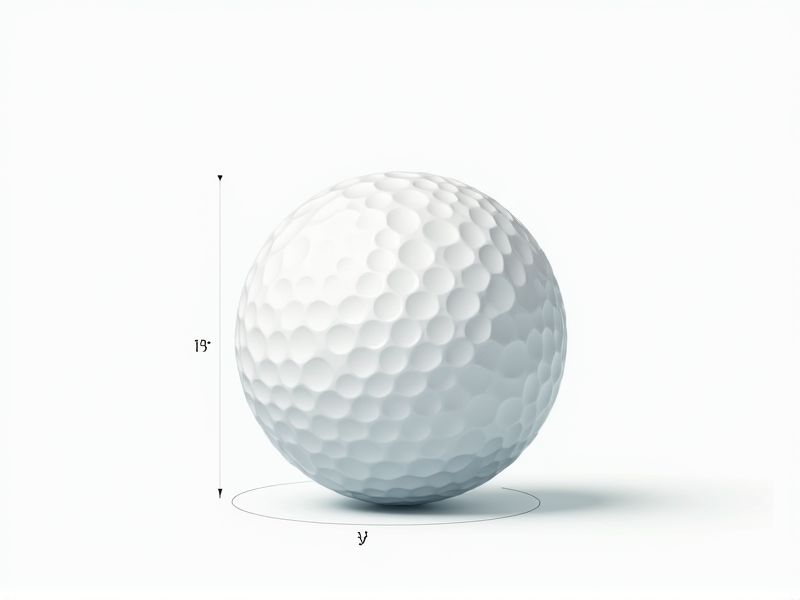
A standard golf ball must adhere to specific dimensions set by the Rules of Golf. It should have a minimum diameter of 1.68 inches (42.67 millimeters), which ensures consistency in play and equipment worldwide. Additionally, the ball must not weigh more than 1.62 ounces (45.93 grams), and its shape must be symmetrical to promote fair performance. Knowing these dimensions helps golfers ensure their equipment meets regulations for practice or official competition.
Diameter: 1.68 Inches
The standard diameter of a golf ball is precisely 1.68 inches, which ensures consistency in gameplay and performance across various courses. This specific measurement is essential as it affects aerodynamics and distance traveled when struck. In competitive golf, adhering to this diameter is crucial, as deviations could result in penalties or disqualification. You can expect that all certified golf balls meet these stringent requirements, contributing to a fair and standardized playing experience.
Circumference: 5.28 Inches
The standard golf ball has a circumference of 5.28 inches, which is crucial for aerodynamic performance. This measurement ensures that the ball maintains optimal flight stability and distance during play. With a diameter of approximately 1.68 inches, every standard golf ball meets the regulations set by organizations like the USGA and R&A. Adhering to these specifications enables golfers to achieve consistent results in their game.
Weight: 1.62 Ounces
A standard golf ball weighs 1.62 ounces, which is crucial for optimal performance in the sport. This weight contributes to the ball's flight characteristics, ensuring it travels precisely and predictably through the air. The construction materials and design also play a vital role, with many golf balls featuring a core surrounded by layers of polymer for added durability and distance. Understanding these specifications can help you make informed choices when selecting golf balls tailored to your playing style.
Volume: 2.48 Cubic Inches
The standard volume of a regulation golf ball is 2.48 cubic inches, which translates to approximately 40.7 milliliters. This volume is crucial for optimizing the ball's flight characteristics and overall performance on the course. Compliance with this measurement ensures that the ball adheres to the United States Golf Association (USGA) regulations. Knowing this standard can help you make informed choices when selecting golf balls for practice or tournament play.
Surface Area: 8.96 Square Inches
The standard golf ball features a surface area measuring 8.96 square inches, a critical dimension that contributes to its aerodynamic performance. This size adheres to regulations set by the United States Golf Association (USGA) and helps ensure consistent play and performance across different courses. With its dimpled pattern enhancing lift and reducing drag, the design optimizes flight stability while maximizing distance. Knowing this surface area can help you better understand how your equipment influences your game.
Dimples: 300-500 Dimples
A standard golf ball typically features between 300 and 500 dimples, which play a crucial role in enhancing aerodynamics and overall performance. These dimples create a turbulent boundary layer of air, reducing drag and allowing the ball to achieve greater distance and stability in flight. The specific dimple pattern and depth can significantly influence how the ball behaves in the air, impacting lift and spin rates. Choosing a golf ball with the right dimple configuration can greatly improve your game and help you achieve more accurate shots.
Dimple Depth: 0.010 Inches
The optimal dimple depth for a golf ball is set at 0.010 inches, significantly influencing flight characteristics and overall performance. This specific depth allows for the ideal combination of lift and drag, which enhances stability and distance during play. Golf balls designed with this standard experience better aerodynamics, leading to improved accuracy and consistency in shots. If you're looking to improve your game, consider how this dimple depth impacts the ball's trajectory and your overall performance on the course.
Material: Surlyn Or Urethane Cover
The standard golf ball typically features a cover made from either Surlyn or urethane, influencing performance and feel. Surlyn, a durable material, offers enhanced resistance to cuts and increased distance, making it ideal for beginners and high-handicap players. Conversely, urethane covers provide superior spin control and a softer feel, catering to advanced players seeking precision and feedback around the greens. Choosing between Surlyn and urethane ultimately depends on your playing style and skill level, impacting your overall game experience.
Core: Solid Or Multilayer Core
The core of a golf ball significantly influences its performance, particularly in terms of distance and feel. A solid core typically provides a firmer feel, resulting in a lower spin rate, which can enhance distance on drives. In contrast, a multilayer core offers a more responsive feel and increased control around the greens, often incorporating different materials to optimize performance across various swing speeds. If you are looking for a golf ball that balances distance and control, consider the specific benefits of each core type based on your playing style.
Conformity: Must Meet Usga And R&A Regulations
Golf balls must adhere to strict regulations set forth by the USGA (United States Golf Association) and the R&A (Royal and Ancient Golf Club), ensuring compliance with standards for size, weight, and performance characteristics. Specifically, golf balls should have a diameter of at least 1.68 inches (4.27 cm) and weigh no more than 1.62 ounces (45.93 grams). These organizations also regulate the ball's initial velocity, distance traveled, and spin rates to guarantee fair play and consistent performance across all levels of the game. By meeting these conformity standards, golf balls provide a uniform playing experience for all golfers, maintaining the integrity of the sport.
